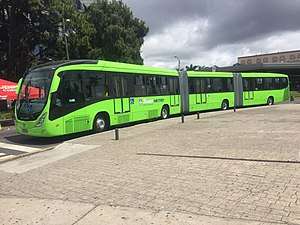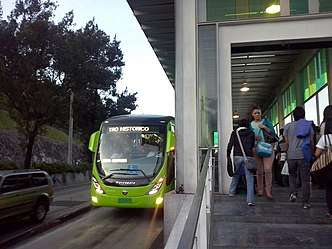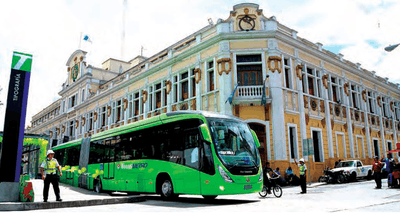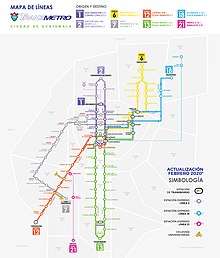Transmetro
Transmetro is a bus rapid transit system in Guatemala City, Guatemala. The first line opened on February 3, 2007. The fleet consists of modern Volvo buses made by Ciferal in Brasil. The buses have fixed stops and partly run on dedicated lanes, avoiding other traffic. Both stops and vehicles are guarded by municipal police. Service began in 2007 with a route between the City Hall (Municipalidad) and a market place at Centra Sur (Southern Transfer Station). The second route, Eje Central, started operations on August 14, 2010. This route serves the central corridor between 6th and 7th Avenue of Zones 1, 4, and 9.
 Transmetro Guatemala City | |
| Overview | |
|---|---|
| Owner | Guatemala City |
| Locale | Guatemala City, Guatemala |
| Transit type | Bus rapid transit |
| Number of lines | 6 |
| Line number | Line 1 Centro Historico (Historic Centre)
Line 2 Hipodromo del Norte (Northern Racecourse) Line 6 Norte (North) Line 12 Centra Sur (South Centre) Line 13 Corredor Central (Central Corridor) Line 18 Nor-oriente (North west) Line 21 Express Zona 21 (Zone 21 Express) |
| Number of stations | 78 |
| Daily ridership | About 120,000 |
| Annual ridership | 520 Million passengers since opening |
| Website | muniguate |
| Operation | |
| Began operation | February 3, 2007 |
| Operator(s) | Municipalidad de la Ciudad de Guatemala (Municipality of Guatemala City) |
| Number of vehicles | About 300:
~13 Bi-articulated bus ~48 Articulated bus ~239 Non-Articulated bus |
| Headway | Average of 5 Minutes during peak periods |
| Technical | |
| Average speed | 60 km/h (37.28 mph) |
Buses run down the middle of the street, separated from other traffic, and stop at stations approximately every kilometre. The stations are in the middle of the street, located near areas of heavy pedestrian activity. Platforms are elevated so as to be level with the floor of the bus. Passengers may access the station via stairways, street crossings, or in some places, tunnels. Elevator access for the disabled is not presently available. However, individuals requiring accessible entry can cross the street to access transportation through gates painted with a wheelchair logo. Roofs in the stations are covered with a transparent plastic covering.
The buses are articulated Brazilian-made vehicles manufactured by Volvo and can carry approximately 100 passengers, including standing passengers.
Security is provided by Guatemala City's transit police. Officers in fluorescent yellow vests are situated at most stations on the route. Sometimes security personnel ride on the Transmetro.
History
The southern line was first completed with funding from the Municipal government of Guatemala city, however, the central line was funded by a private initiative. On February 3, 2007, when the buses started to operate on the southern line, regional buses or "Chicken Buses" were banned from entering the city from the south roads. This change effectively made travelling the CA1 much faster compared before the line began to work.
Chronological History[1]
- January 1999: Mayor Fritz Garcia Gallont offers to implement the Transmetro project, unfortunately it doesn't happen within his administration.
- January 2004: Alvaro Arzu, after being elected as mayor for a second term, confirmed that he considered the Transmetro as a solution to alleviate congestion in the city.
- June 2004: The city council says the first phase would be completed by the end of the year.
- December 2004: City council announces that they would push the opening date to late 2005.
- June 2006: City council pledges to do its best effort to complete phase 1 by the end of the year.
- December 2006: The opening date is pushed to January 2007.
- January 2007: Due to delays in completing from infrastructure, the opening date is pushed by one month to February 2007.
- February 3, 2007: Phase one, renamed "Eje Sur" (South line), begins operating in the city.
- August 14, 2010: The second phase opens, renamed "Eje central" also known as "Corredor Central" (Central line, or also known as Central corridor).[2]
- December 2012: A short line begins to operate in the Historic Downtown aka "Centro Historico"
- April 2014: A new line begins to operate to serve Zone 18 from the Atlantida neighbourhood to the Downtown core.
- 2014: Construction begins for the northern line, later renamed line 6 after the Zone in which it terminates from the downtown core.
- April 2015: Line 6 (Eje Norte), begins service.[3]
- January 2016: A new short line opens to serve the Racecourse neighbourhood to the downtown core[4]
- 2016: All lines were renamed after the zones they operate in or serve. Eje Sur was renamed Line 12 as it mainly operates in zone 12, Corredor Central was renamed Line 13 as it connects Zone 13 with the Downtown Core, Cnetro Historico was renamed Line 1 as it serves the Zone 1 Downtown, Eje Norte was renamed Line 6 as it terminates in Zone 6, Eje Nor-oriente is renamed Line 18 as it terminates in Zone 18, Hipodromo was renamed Line 2 as it serves Zone 2.
- 2017: Line 21 begins operating as a pilot project to improve transportation to and from the USAC University campus. It had not yet been changed to a permanent route but is marked on the map as the pink line.

Fare payments
When the Transmetro first opened, it only accepted coins as the fare was set at Q1.00 (CAD$0.17). After the national government began service of the Transurbano, a local bus service similar to the ones in North American cities, it also began to accept the cashless prepaid card which had to be tapped to a reader. Passengers must pay the fare each time they enter the Transmetro, which means a two way trip costs Q2.00 regardless of where how far you go. On November 2015, payments by the prepaid card were no longer accepted due to a multitude of problems and disagreements. As of today, the payment can only be done by coins.
Routes
Line 12 (Centra Sur)
Line 12 starts from Zone 1 in Guatemala City, it runs through the Civic Centre, Bolivar Avenue, Trebol Station, Raul Aguilar Batres Way and finally terminating at Centra Sur, in Zone 12 of neighbouring Villa Nueva city.
Branches
| Route | Destinations |
|---|---|
| L12 | Paradas Continuas (local): Centra Sur / FEGUA-Plaza Barrios |
| L12 D | Directo (express): Centra Sur to Trebol / Express: Trebol to Centra Sur. |
| L12 D | Directo (express): Centra Sur to Amate via Trebol (Northbound Only) |
Stations
| Connecting Lines | Station name |
|---|---|
| L12 | Centra Sur |
| L12 D | |
| L12 D | |
| L12 | Monte Maria Station |
| L12 | Javier Station |
| L12 | Las Carchas Station |
| L12 | El Carmen Station |
| L12 | Reformita Station |
| L12 | Mariscal Station |
| L12 | Trebol Station |
| L12 D | |
| L12 D | |
| L21 | |
| L12 D | Amate Station (Only serviced during morning and evening rush hours) |
| L12 | Santa Cecilia Station |
| L12 | Bolivar Station |
| L12 | Don Bosco Station |
| L12 | Calvario Station |
| L13 | |
| L12 | Municipal Plaza Station |
| L12 | Plaza Barrios-Fegua Station |
| L13 | |
| L6 | |
| L18 |

Line 13 (Corredor Central)
The second line to be opened, Corridor Central or Eje Central, runs through zones 4, 9, and 13 of Guatemala City. The buses are similar to the ones on Line 12, except for the Bi-articulated buses. The change in bus types was done to allow the line to travel through the historic centre as the streets are narrower compared to those of the CA1.
Another interesting difference between Line 12 and Line 13 is that, when Line 13 was still a proposal, the developer promised to revitalize the areas where the Line would eventually operate. This revitalization included new monuments, better sidewalks, improvement of street vendor spaces, and others.
Line 13 connects with Line 12 at "Plaza Barrios" and "El Calvario", creating seamless connections to the downtown and the southern areas of the city. Stations on this line are equipped with accessibility features such as braille that tells users the name of the stations and the connecting lines.
This line, as mentioned earlier, runs through the historic downtown, this means that during its journey it will pass by popular landmarks of the city such as the Torre del Reformador, the Acueducto de Pinula, the Bank of Guatemala, Civic Centre, and 6th Avenue, a popular pedestrian-only section of the city.
Branches
| Route | Destinations |
|---|---|
| L13 | Plaza Barrios Station to Banco de Guatemala Station |
Stations
| Connecting Lines | Station Name |
|---|---|
| L13 | Plaza Barrios-Fegua Station |
| L12 | |
| L6 | |
| L18 | |
| L13 | Tipografia Station |
| L1 | |
| L13 | El Calvario Station |
| L12 | |
| L13 | 4 Grados Sur Station |
| L13 | Exposicion Station |
| L13 | Terminal Station |
| L13 | Industria Station |
| L13 | Tivoli Station |
| L13 | Montufar Station |
| L13 | Acueducto Station |
| L13 | Hangares Station |
| L13 | |
| L13 | Argentina Plaza Station |
| L13 | |
| L13 | Los Arcos Station |
| L13 | Spain Plaza Station |
| L13 | IGSS Zona 9 Station |
| L13 | Seis 26 Station |
| L13 | Torre del Reformador Station |
| L13 | Plaza of the Republic Station |
| L13 | Banco de Guatemala Station |
Line 13 was expanded to service further into zones 9 and 10, which due to road limitations forced it to be broken up into 2 segments. The ones listed above are part of the first segment and the ones below are part of the second segment.
| Branch | Station Name |
|---|---|
| L13 | Argentina Plaza Station |
| L13 | |
| L13 | Hangares Station |
| L13 | |
| L13 | Berlin Plaza Station |
| L13 | Juan Pablo II Station |
Line 1 (Centro Historico)
Line 1 works in mainly in Zone 1 of Guatemala's Downtown. This line was built soon after Line 13 began operations. The main goal of this line was to make the historic centre more accessible through safe and reliable public transportation. This line travels from 3rd Street in Zone 1, towards 18th Street in Zone 1, passing through 5th Street and 8th Street. This line started service on December 19th, 2012. [5]

Branches
| Route | Destinations |
|---|---|
| L1 | Centro Historico to San Sebastian Station (Northbound) Centro Historico to Tipografia Station (Southbound) |
Stations
| Connecting Lines | Station Name |
|---|---|
| L1' | Gomez Carrillo Station |
| L1 | San Agustin Station |
| L1 | Parque Centenario Station |
| L1 | San Sebastian Station |
| L2 | |
| L1 | Mercado Central |
| L1 | Correos Station |
| L1 | Beatas de Belen Station |
| L1 | Tipografia Station |
Line 2 (Hipodromo)
Line 2 was another line that had some private sector support, the goal was to increase ease of travel between the Hipodromo district and the historic district. The colour for this route is similar to the one for Line 1, as they serve very similar areas. Line 2 also has an express service to provide direct connections between Zone 1, and the UMG university campus. The express service does not serve any other stations.
Branches
| Route | Destinations |
|---|---|
| L2 | Line 2 to Hipodromo del Norte / Line 2 to San Sebastian |
| L2 E | Expresso: Linea 2 to UMG / Expresso: Linea 2 to San Sebastian |
Stations
| Connecting Lines | Station Name |
|---|---|
| L2 | San Sebastian |
| L2 E | |
| L1 | |
| L2 | Asuncion |
| L2 | Hipodromo del Norte |
| L2 | Simeon Cañas |
| L2 | Jocotenango |
| L2 E | UMG |
Line 6 (Norte)
L6 or Eje Norte, runs from 18th Street in Zone 1 to Cementos Progreso Stadium in Guatemala's Zone 6, on its journey, it passes by the popular Colon Park (Parque Colon). Its stations began construction in October 2014 and the route was fully functional by April 25th of 2015[6]. A trip from one end to the other takes an average of 50 minutes[3].
Branches
| Route | Destinations |
|---|---|
| L6 | Linea 6 to Proyectos (Northbound) Line 6 to Plaza Barrios-Fegua (Southbound) |
Stations
| Connecting Lines | Station name |
|---|---|
| L6 | Plaza Barrios-Fegua Station |
| L18 | |
| L13 | |
| L12 | |
| L6 | Santa Clara Station |
| L18 | |
| L6 | Colon Station |
| L18 | |
| L6 | La Merced Station |
| L18 | |
| L6 | Cerro del Carmen Station (Northbound) |
| L18 | |
| L6 | Parroquia Station |
| L6 | IGSS Zona 6 Station |
| L6 | Centro Zona 6 Station |
| L6 | Academia Station |
| L6 | Cipresales Station (Northbound) |
| L6 | Proyectos 4-4 Station (Northbound) |
| L6 | Proyectos Station |
| L6 | Proyectos 4-4 Station (Southbound) |
| L6 | Cipresales Station (Southbound) |
| L6 | Quintanal Station |
| L6 | Corpus Christi Station |
| L6 | Jose Marti Station |
| L6 | Cerro del Carmen Station (Southbound) |
| L6 | Santa Teresa Station |
| L6 | Capuchinas |
| L18 | |
| L6 | Beatas de Belen |
| L18 | |
| L1 |

Line 18 (Nor-oriente)
As its name in Spanish describes, this line travels to the North West corner of the city. Departing from Plaza Barrios-FEGUA Station at 18th Street in Zone 1, ti travels through very important, high traffic areas and sites of interest like Colon Park. This line began operating on April 25th 2014 and continues to be under construction specially in the northern segment of the route to improve road conditions and exclusive traffic lane. This line also has an express service which bypasses most stations and travels directly to Paraiso Station, stopping at San Rafael Station on the way. Geographically, Paraiso is further than Atlantida, making it the northernmost station in the system. In early 2020, Transmetro completed the newest terminal station at Atlantida, renaming the terminal to "Centra Atlantida[7]". This new terminal also provides direct transfers to local Transurbano Routes in the 300 Series.
Branches
| Route | Destinations |
|---|---|
| L18 | Line 18 to Centra Atlantida / Line 18 to Plaza Barrios-FEGUA Station |
| L18 Expresso | Line 18 to Paraiso Station / Line 18 to Plaza Barrios-FEGUA Station |
Stations
| Connecting Lines | Station name |
|---|---|
| L18 | |
| Plaza Barrios-Fegua Station | L6 |
| L13 | |
| L12 | Santa Clara Station |
| L18 | |
| L6 | Colon Station |
| L18 | |
| L6 | La Merced Station |
| L18 | |
| L6 | Cerro del Carmen Station (Northbound) |
| L18 | |
| L6 | San Marin Station (Northbound) |
| L18 | Victorias Station (Northbound) |
| L18 | Portales Station |
| L18 | Centra Atlantida (formerly Atlantida Station) |
| L18 | Alamos Station |
| L18 | Victorias Station (Southbound) |
| L18 | San Martin Station (Southbound) |
| L18 | Capuchinas Station |
| L18 | |
| L6 | Beatas de Belen |
| L18 | |
| L1 |
Line 21
Line 21 started as a pilot project to measure sustainability, and conduct a user needs assessment for service to the USAC university campus[8], in the southern end of the city. The project began as an Express service between the temporary Trebolito Station, which was close to the Trebol Station, and a temporary Station at the municipal office in Zone 21. Th service has since become a permanent line which provides easier access to the university campus from Line 12. In 2019, the service was complimented by the opening of the Line 7 service which provides students with options for westbound service. The line is named after its southern terminus, located in Zone 21.
Branches
| Route | Destinations |
|---|---|
| L21 | Linea 21 Trebol / Linea 21 Nimajuyu |
Stations
| Connecting Lines | Station Name |
|---|---|
| L21 | Trebol |
| L12 | |
| L12 D | |
| L12 D | |
| L21 | USAC Petapa |
| L21 | Nimajuyu (formerly Alcaldia Auxiliar Z.21) |
Line 7
Line 7 is the newest Transmetro line, it began service in late 2019 and has now been fully enabled as a functioning line.[9] Line seven is intended to cover more suburban service, as well as provide more direct access to the USAC university campus. The line travel between Colon Station in Zone 1, through Zone 7, Zone 11, and terminates at the new USAC Periferico Station. Along the way, it makes direct transfers to Line 6 and 18, while also providing walking connections to Line 1 and 12.
Branches
| Route | Detinations |
|---|---|
| L7 | Linea 7 to Colon / Linea 7 to USAC Periferico |
Stations
| Connecting Lines | Station Name |
|---|---|
| L7 | Colon |
| L6 | |
| L18 | |
| L7 | La Merced |
| L6 | |
| L18 | |
| L7 | Cruz Roja |
| L7 | Archivo General |
| L7 | Santuario de Guadalupe |
| L7 | Incienso |
| L7 | Bethania |
| L7 | 4 de Febrero |
| L7 | Villa Linda |
| L7 | Ciudad de Plata II |
| L7 | San Juan |
| L7 | Roosevelt |
| L7 | San Jorge |
| L7 | Cejusa |
| L7 | Rodolfo Robles |
| L7 | Granai |
| L7 | Aguilar Batres |
| L7 | USAC Periferico |
| L7 | **Same stations northbound, up to Incienso** |
| L7 | San Juan de Dios |
| L7 | Pasaje Aycinena |
References
- "Comuna habilita Transmetro | Siglo21.com.gt". web.archive.org. 2012-12-21. Retrieved 2019-05-25.
- "Implementan nomenclatura Braile en Paseo La Sexta y el Corridor Central del Transmetro". elPeriodico de Guatemala. February 4, 2011.
- "Transmetro empieza a circular para la zona 6 – Prensa Libre" (in Spanish). Retrieved 2019-05-25.
- ":::... Tú eres la Ciudad - Municipalidad de la Ciudad de Guatemala, Cumple ...:::". web.archive.org. 2014-10-03. Retrieved 2019-05-25.
- "Habilitan servicio de Transmetro en Centro Histórico | Siglo21.com.gt". web.archive.org. 2012-12-21. Retrieved 2019-05-26.
- "Wayback Machine" (PDF). web.archive.org. 2014-11-29. Retrieved 2019-05-26.
- Redacción. "Estación de Transmetro en la Atlántida atenderá hasta 60 mil personas cada día". centranews.com.gt (in Spanish). Retrieved 2020-08-18.
- "Servicio de Transmetro empieza a funcionar en la zona 21 este sábado – Prensa Libre" (in Spanish). Retrieved 2020-08-18.
- "Inauguran primera fase de Línea 7 del Transmetro que recorrerá de la Usac a la zona 1 – Prensa Libre" (in Spanish). Retrieved 2020-08-18.
External links
- (in Spanish) Municipalidad de Guatemala page
- Article about public transport in Guatemala City on CityMayors.com
- Transurbano Map.